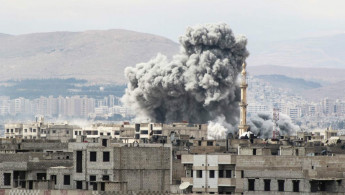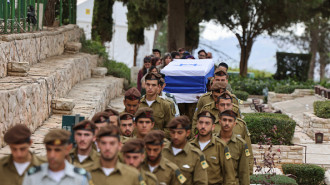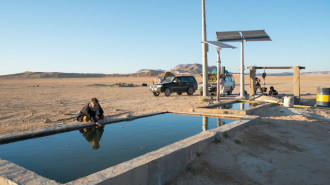Syria regime used minesweepers as 'weapon of war' in assaults on rebel towns
The Syrian regime illegally used minesweepers to bombard opposition towns and kill civilians, a new report by the Syria Justice and Accountability Center (SJAC) has revealed.
The UR-77 and UR-83P mine clearance vehicles were frequently deployed during indiscriminate attacks on opposition-held towns in the Damascus region between 2014 and 2019, a tactic that is illegal under international law.
Designed for minefields, these vehicles fire a projectile fitted with high explosives into the area containing mines or IEDs, which is then detonated via a fuse attached to the vehicles from a safe distance.
The Syrian regime instead used these as a weapon of war against opposition towns, the SJAC revealed, leaving whole families buried under the rubble of their homes with no chance of rescue.
The centre documented 30 cases of UR-77s and UR-83Ps being used across Syria between 2014 and 2019, via videos and images. However, it focused on four of 15 cases with the clearest visual evidence for the report.
This includes examples in the Al-Qaboun, Jobar, Harasta, and Al-Yarmouk Camp areas of Damascus, which were all subject to ferocious assaults by regime forces during their capture from opposition forces, overall resulting in the deaths of thousands of civilians.
The SJAC reported that the first UR-77s and UR-83Ps appeared in Syria in 2014, likely purchased from Russia or Belarus.
Russia had already used UR-77 minesweepers against civilian areas during the Second Chechen War (1999-2009), destroying a major bridge and homes in the Republic of Chechnya.
"These actions were borrowed from Russian military strategy which dates back to the Second
Chechen War and is now used in the Ukraine conflict," said SJAC's Executive Director, Mohammad Al-Abdallah.
It is a tactic Moscow's ally, the Assad regime, was only too happy to replicate in Syria, reducing whole streets to rubble with destruction so immense that four to five years later, families are still unable to return to their homes.
"Apparently, the regime did not care about verifying the type of target, it was interested in targeting any place where it monitored movement, so the shelter sites were the most targeted, a lot of shelters were targeted and people either were killed or remained stuck in their shelters to face their inevitable fate of death," a witness from Yarmouk, a Palestinian refugee camp near Damascus, told the SJAC.
There is no way of knowing how many civilians were killed in these attacks, but witnesses recounted the frequent targeting of shelters and other civilian infrastructure, coinciding with the aerial bombardment and artillery strikes on the camp.
"I witnessed a massacre that took place against forty people, and I am sure their bodies are still in the basement in which they were hiding," one witness in Yarmouk said in the report.
E. Ghouta: footage showing government assault on Rayhan front with UR-77, seizing some Jaish Islam's positions in outskirts. Battle ongoing there for 2nd week. https://t.co/tGpUXNBO1F pic.twitter.com/XgKQjegdsk via @QalaatAlMudiq #Syria
— Liveuamap MiddleEast (@lummideast) March 15, 2018
"I passed after the attack, and the building was completely destroyed above them, and I heard the sounds of groaning and pleading for help, but no one could do anything."
The Syrian regime has frequently used barrel bombs, sarin gas, chlorine, and other indiscriminate weapons, banned under international law, against civilian areas during the war, which broke out in 2011 after the violent suppression of peaceful protests.
At least 500,000 people have been killed in the 12-year war, the vast majority as a result of regime bombardment of civilian areas.





 Follow the Middle East's top stories in English at The New Arab on Google News
Follow the Middle East's top stories in English at The New Arab on Google News


